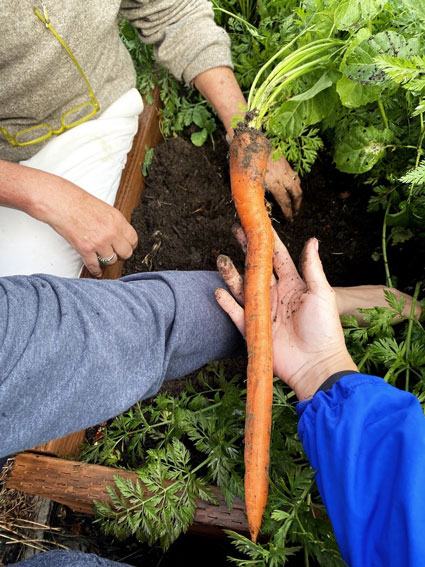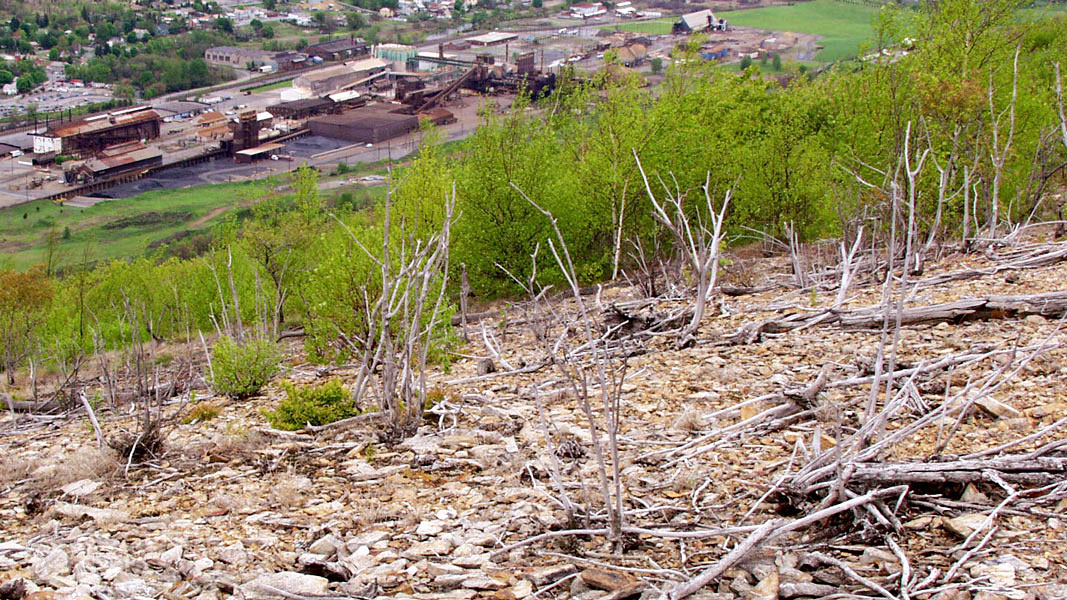Top: The clearly delineated tree border marks where biosolids application ended at a Superfund site in Pennsylvania. Heavy-metal contaminated soil resulted in a denuded and eroded hillside featuring driftwood-like dead trees (foreground). Life returned in the form of lush new trees (downslope) within the biosolids application zone. Photo by Doug Pinkerton
 Sally Brown
Sally Brown
In general, I avoid reading books or watching movies that are at all related to soil. I read enough peer reviewed papers on the topic. I’ve found, with few exceptions, that most of these environmental books/movies emphasize the evils of humanity, often using “toxic sludge” as one of the examples. They also tend to paint a bucolic picture of life before humanity — or at least humanity in the modern age. They make you feel akin to that “toxic sludge” that they describe and typically don’t provide any tools to make the situation better. You end up feeling like your best option is to stop eating, using the toilet, turning on the lights or leaving the basement. So, I was not happy when a colleague that I respect not only recommended that I read Braiding Sweetgrass but actually got me an audio copy of the book. This was high on my avoid-reading-at-any-cost list, a book that I had been deliberately ignoring for close to a decade.
But I sucked it up and made it through. The author, Dr. Robin Wall Kimmerer, is a botanist at one of the universities in the New York system. She is also a member of the Potawatomi Nation. Her main points are that we need to develop a sense of reciprocity with nature. We take, but we also need to give back. When taking, she emphasizes, take only as much as you need and leave some for others. She also is very clear that animals, lakes, plants, the sky, and the stars are all animate beings, worthy of recognition and respect.
In the author’s case, she gives back tobacco, sprinkling some after she harvests. This is likely a reflection of the historic value of tobacco in the Potawatomi culture rather than a desire to get plants interested in Marlboros. Things that Dr. Wall Kimmerer recommends are primarily limited to understanding and appreciating the beauty of nature. Urban agriculture is the closest she comes to recommending positive things that people can do. The toilet and the green bin do not merit mention.
And yes, there is the section on sludge. In this case it is in reference to dumping “sludge” on a Superfund site near where she lives. This was written more as an example of adding insult to injury rather than as an effective tool to right past wrongs.
Reciprocity Of Biosolids And Composts

If we take Dr. Wall Kimmerer literally, writes Sally Brown (above in one of her gardens), and listen to the soils and the plants, the story that they tell us is very different from the focus of most of the scientific literature.
But what if you took her basic premise, the notion of reciprocity and looked at biosolids and composts as tools for giving back? What if you recognized plants as quasi sentient beings and trusted them? What if instead of viewing these materials as the source of contaminants, you considered them as a critical part of the natural cycle?
In the scientific literature the focus is always biosolids as a potential hazard. And that is also what most people know, if they know anything at all about municipal wastewater. In general, it is flush and forget. In the 30 odd years that I’ve been working with biosolids the specific hazard has changed. First it was metals from industrial discharges, there was a brief foray into organics such as dioxins and flame retardants (polybrominated diphenol ethers or PBDEs). From there pharmaceuticals and personal care products took the stage. As that has died down, the big emphasis went to perfluorinated organics, forever chemicals aka PFAS. If there is even a sign that the furor over those is slowly subsiding, don’t despair, microplastics are on the rise. As a well-respected soil chemist who worked with biosolids once said, it’s the contaminant du jour.
The primary change in these papers that I’ve noticed over the decades is now there are a few sentences in the beginning noting that biosolids recycling provides important soil nutrients. However, these papers in general fall into the trap of another example of how people are destroying the earth.

Biosolids were applied to a Superfund site in Tar Creek, Oklahoma. Pre (left) and post treatment (right). Photos by Sally Brown
What is only sparingly in the literature and very rarely in the public discourse are the benefits associated with these materials. Back in the day, before centralized wastewater treatment, in many cultures human waste was considered a valuable resource. This is well summarized in Flush: The Remarkable Science of an Unlikely Treasure, a recent book by Bryn Nelson. The understanding of the relationship between untreated poop and pathogens overrode that understanding. Poop went from a prized commodity for farmers to the source of diarrhea and disease. Now with centralized treatment, you can have your cake and eat it (not literally) too. Same deal with municipal or commercial composting facilities. If you ask people who have actually used biosolids, the vast majority would agree wholeheartedly. Even the fabled Terra Preta soils in Brazil benefited not just from biochar, but from organics returned to the soil in their wet, slimy form.
You are also seeing a recognition in the literature that the basic ingredients, #s 1 and 2, are some good sh##t. Many of these recommend decentralized systems as the centralized systems are seen almost as evil doers rather than the advances in public and environmental health that they are. Same deal with home composters. The fact is that not everyone has the interest, the time, the space to install urine diverting composting toilets in their condos, let alone compost bins.
How Biosolids Give Back
I first came to look at biosolids as a resource when we used them to restore some of the most poisoned sites on the U.S. EPA’s Superfund list. Sites that had been barren for over 100 years turned lush after a single application (albeit when mixed with lime and at a high loading rate). Because in addition to those parts per billion (ppb or 1 in 1,000,000,000) hazards, these biosolids and composts contain organic matter to feed the soil and all who live in it. They contain all the minerals — not in ppb but in percent concentrations (1 in 100) to nourish the soils and all that grow in them. When we put these materials back into soils we are showing reciprocity. When we take our uneaten food and put it in the compost pile instead of the landfill, we are doing our best to not take more than we need. We are giving the rest back for others to benefit from. And if we take Dr. Wall Kimmerer literally and listen to the soils and the plants, the story that they tell us is very different from the focus of most of the scientific literature.

This carrot grown in garden soil amended with Tagro, a biosolids product made by Tacoma (WA), is an example of plants telling us the truth.
I have seen how the plants react on Superfund sites, in urban gardens, on dryland wheat, on my houseplants and in my own garden. We recently did some satellite analysis and found that you can even see the growth improvement from space (unpublished data). I would argue, as did Dr. Wall Kimmerer in Braiding Sweetgrass, that plants are telling us the truth. In this case, it seems that they are smarter than most of us. When given opportunity, I have seen how people react when they realize just what they can grow. That there is something that they can do that helps. There is a type of wonder that comes across people’s faces when they understand the process. Perhaps this is best put by a classmate of my son’s way back when he was in elementary school. We went on a tour of the Tacoma (WA) wastewater treatment plant and its garden. The kid realized that after he eats, he makes poop, that poop comes to the plant, the plant makes it into Tagro that you then use to grow more food. Talk about a perfect circle.
Wouldn’t the world be a wonderful place if we all were given the tools and the motivation to realize this? Wouldn’t it be amazing if people were told that they could be part of a solution just by flushing and putting the right stuff in the green bin? This is something that I’ve been working on since before I went back to graduate school. This is something that BioCycle has been working on for 65+ years. I would be just fine if it came to pass and I was out of a job. I already have my next career planned. Teaching grown-ups not to be afraid of the water. I figure 30+ years of getting them not to be afraid of their own poop will be a good head start.
Sally Brown, BioCycle Senior Adviser, is a Research Professor at the University of Washington in the College of the Environment.













